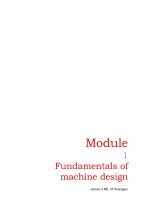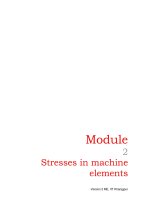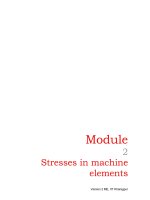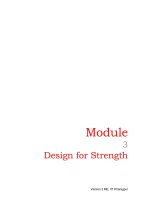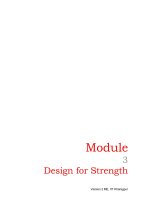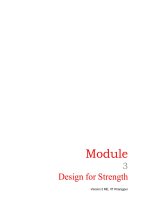Tài liệu Fundamentals of Machine Design P5 doc
Bạn đang xem bản rút gọn của tài liệu. Xem và tải ngay bản đầy đủ của tài liệu tại đây (487.34 KB, 15 trang )
Version 2 ME, IIT Kharagpur
Module
2
Stresses in machine
elements
Version 2 ME, IIT Kharagpur
Lesson
2
Compound stresses in
machine parts
Version 2 ME, IIT Kharagpur
P
A
σ=
My
I
σ=
VQ
It
τ=
J
T
r
τ
=
Instructional Objectives
At the end of this lesson, the student should be able to understand
• Elements of force system at a beam section.
• Superposition of axial and bending stresses.
• Transformation of plane stresses; principal stresses
• Combining normal and shear stresses.
2.2.1 Introduction
The elements of a force system acting at a section of a member are axial force,
shear force and bending moment and the formulae for these force systems were
derived based on the assumption that only a single force element is acting at the
section. Figure-2.2.1.1 shows a simply supported beam while figure-2.2.1.2
shows the forces and the moment acting at any cross-section X-X of the beam.
The force system can be given as:
Axial force :
Bending moment :
Shearforce :
Torque :
where, σ is the normal stress, τ the shear stress, P the normal load, A the cross-
sectional area, M the moment acting at section X-X, V the shear stress acting at
section X-X, Q the first moment of area, I the moment of inertia, t the width at
which transverse shear is calculated, J the polar moment of inertia and r the
radius of the circular cross-section.
Version 2 ME, IIT Kharagpur
P
1
P
2
P
3
X
X
δ
W
P
P
ANIMATE
2.2.1.1F- A simply supported beam with concentrated loads
2.2.1.2F- Force systems on section XX of figure-2.2.1.1
Combined effect of these elements at a section may be obtained by the method
of superposition provided that the following limitations are tolerated:
(a) Deformation is small (figure-2.2.1.3)
2.2.1.3A- Small deflection of a simply supported beam with a concentrated
load
If the deflection is large, another additional moment of Pδ would be
developed.
(b) Superposition of strains are more fundamental than stress superposition
and the principle applies to both elastic and inelastic cases.
2.2.2 Strain superposition due to combined effect of axial
force P and bending moment M.
Figure-2.2.2.1 shows the combined action of a tensile axial force and bending
moment on a beam with a circular cross-section. At any cross-section of the
beam, the axial force produces an axial strain ε
a
while the moment M causes a
V
P
M
Version 2 ME, IIT Kharagpur
bending strain. If the applied moment causes upward bending such that the
strain at the upper most layer is compressive (-ε
2
) and that at the lower most
layer is tensile (+ε
1
), consequently the strains at the lowermost fibre are additive
(ε
a
+ε
1
) and the strains at the uppermost fibre are subtractive (ε
a
-ε
2
). This is
demonstrated in figure-2.2.2.1.
2.2.2.1F- Superposition of strain due to axial loading and bending
moment.
2.2.3 Superposition of stresses due to axial force and
bending moment
In linear elasticity, stresses of same kind may be superposed in homogeneous
and isotropic materials. One such example (figure-2.2.3.1) is a simply supported
beam with a central vertical load P and an axial compressive load F. At any
section a compressive stress of
π
2
4F
d
and a bending stress of
My
I
are
produced. Here d is the diameter of the circular bar, I the second moment of area
and the moment is
PL
2
where the beam length is 2L. Total stresses at the
upper and lower most fibres in any beam cross-section are
⎛⎞
−+
⎜⎟
ππ
⎝⎠
32
32 4
2
MF
dd
and
⎛⎞
−
⎜⎟
ππ
⎝⎠
32
32 4
2
MF
dd
respectively. This is illustrated in figure-2.2.3.2
+
ε
a
-
ε
2
+
ε
1
ε
a
+
ε
1
F
+
M
M
=
Axial strain
Bending strain
Combined strain
F
ε
a
-
ε
2
Version 2 ME, IIT Kharagpur
2.2.3.1F- A simply supported beam with an axial and transverse loading.
2.2.3.2F- Combined stresses due to axial loading and bending moment.
2.2.4 Superposition of stresses due to axial force, bending
moment and torsion
Until now, we have been discussing the methods of compounding stresses of
same kind for example, axial and bending stresses both of which are normal
stresses. However, in many cases members on machine elements are subjected
to both normal and shear stresses, for example, a shaft subjected to torsion,
bending and axial force. This is shown in figure-2.2.4.1. A typical example of this
type of loading is seen in a ship’s propeller shafts. Figure-2.2.4.2 gives a
schematic view of a propulsion system. In such cases normal and shearing
stresses need to be compounded.
P
F
F
LL
F
A
A
−
2
Md
I
+
2
Md
I
−−
2
FMd
A I
−+
2
FMd
A I
M
F
+
=
F
M


